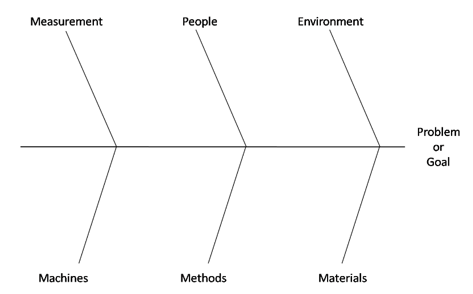
One way to capture these different ideas and stimulate the team’s brainstorming on root causes is the cause and effect diagram, commonly called a fishbone. The fishbone diagram or Ishikawa diagram is a cause-and-effect diagram that helps managers to track down the reasons for imperfections, variations, defects, or failures. The diagram looks just like a fish’s skeleton with the problem at its head and the causes for the problem feeding into the spine. Once all the causes that underlie the problem have been identified, managers can start looking for solutions to Ishikawa diagrams (also called fishbone diagrams, herringbone diagrams, cause-and-effect diagrams, or Fishikawa) are causal diagrams created by Kaoru.Fishbone diagram (The Cause and Effect ) Characteristic and factorsA fishbone diagram helps team members visually diagram a problem or condition's root causes, allowing them to truly diagnose the problem rather than focusing on symptoms. It allows team members to separate a problem's content from its history, and allows for team consensus around the problem and its causes.The fishbone diagram is a very simple tool that permits effective and quick root causes in the pursuit of corrective actions.
These branches are labeled with different categories. The categories you use are up to you to decide. It is a simple tool that is used for brainstorming issues and reasons of particular problems.Meaning of the Characteristic・・・・Result of the workA Fishbone Diagram is a visual tool that allows project teams to easily display a list of potential causes of a problem, then break these causes down into increasingly more detailed components until a link is found between a root cause and the final outcome. Another name for the diagram is the Cause and Effect Diagram or Ishikawa Diagram (named. Loss product quality, product, and production volume for exampleA Fishbone diagram is a focusing tool.
But as we know they are not very efficient at it. The Fishbone diagram is a simple but highly effective tool in problem solving.How We Usually Solve Problems: The management in every organization is in charge of solving everyones problems. It has wide ranging applications in almost all six sigma projects. The fishbone diagram, which also goes by a couple of other names like the Cause and effect diagram and the Ishikawa diagram is one of the seven basic tools of quality management. It is particularly useful in a group setting and for situations in which little quantitative data is available for analysis.The fishbone has an ancillary benefit as well. Because people by nature often like to get right to determining what to do about a problem, this can help bring out a more thorough exploration of the issues behind the problem – which will lead to a more robust solution.To construct a fishbone, start with stating the problem in the form of a question, such as “Why is the help desk’s abandon rate so high?” Framing it as a “why” question will help in brainstorming, as each root cause idea should answer the question.

This line then branches out into several lines, each of which represents a category of problems.Firstly by categorizing problems, we understand the fact that they might have similar root causes. A central line is drawn from the left pointing towards the issue. An issue is listed at the far right hand corner of the diagram. So how exactly does it help in brainstorming? Here is how.
Hence the use of fishbone diagram may become problematic in certain cases. However, in quality management it is a known fact that cause and effect are seldom present in one layer. For instance, in a brainstorming session people may be asked their views on how materials mismanagement is leading to delayed deliveries.Only One Issue per Diagram: The flipside of a Fish-bone diagram is the fact that there can only be one issue per diagram. Therefore when a participant is trying to brainstorm they have a more specific way to look at the problem. This is because Fishbone diagrams have pre-defined categories. However, Fishbone diagrams help in giving structure to the thoughts.
...


 0 kommentar(er)
0 kommentar(er)
